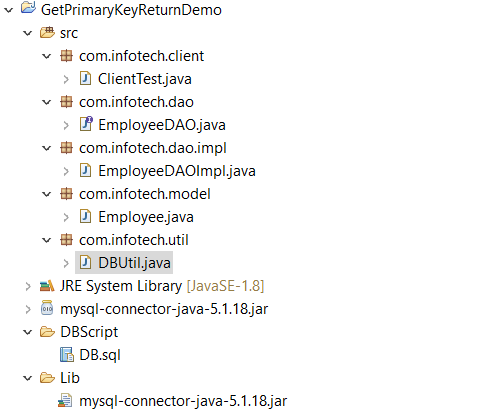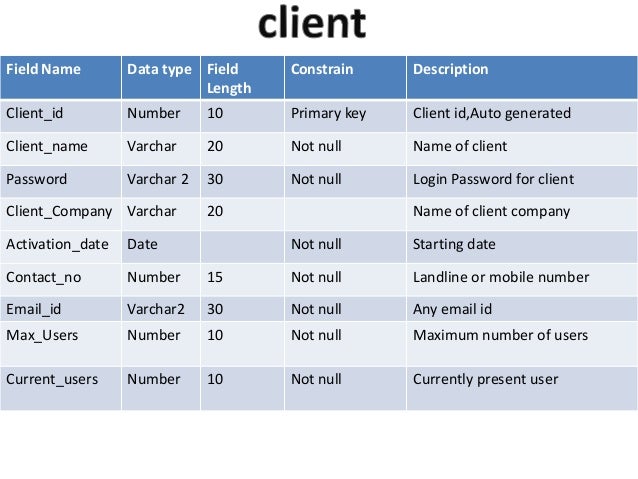Create Primary Keys.; 2 minutes to read +6; In this article. APPLIES TO: SQL Server 2016 and later Azure SQL Database Azure Synapse Analytics (SQL DW) Parallel Data Warehouse You can define a primary key in SQL Server by using SQL Server Management Studio or Transact-SQL. Jan 07, 2020 Auto increment columns widely used for auto-generating values for primary keys in Database tables.Most of the databases like SQL server etc have existing features to create auto increment columns. In Oracle 12c they introduced IDENTITY columns which allows users to create auto increment columns. Oct 11, 2017 Hi @themurf47. Yes, that is possible. PowerApps could take use of the SQL Server table as the data source, or the SharePoint list, both of them contains feature to generate Auto-Increment-ID. Like SQL table Primary Key, or the SharePoint List ID field, which can't be modified by users.
Sql Auto Increment Primary Key
AUTO INCREMENT Field
Auto-increment allows a unique number to be generated automatically when a new record is inserted into a table.
Often this is the primary key field that we would like to be created automatically every time a new record is inserted.
Syntax for MySQL
The following SQL statement defines the 'Personid' column to be an auto-increment primary key field in the 'Persons' table:

Personid int NOT NULL AUTO_INCREMENT,
LastName varchar(255) NOT NULL,
FirstName varchar(255),
Age int,
PRIMARY KEY (Personid)
);
MySQL uses the AUTO_INCREMENT keyword to perform an auto-increment feature.
By default, the starting value for AUTO_INCREMENT is 1, and it will increment by 1 for each new record.
To let the AUTO_INCREMENT sequence start with another value, use the following SQL statement:
To insert a new record into the 'Persons' table, we will NOT have to specify a value for the 'Personid' column (a unique value will be added automatically):
VALUES ('Lars','Monsen');
The SQL statement above would insert a new record into the 'Persons' table. The 'Personid' column would be assigned a unique value. The 'FirstName' column would be set to 'Lars' and the 'LastName' column would be set to 'Monsen'.
Syntax for SQL Server
The following SQL statement defines the 'Personid' column to be an auto-increment primary key field in the 'Persons' table:
Personid int IDENTITY(1,1) PRIMARY KEY,
LastName varchar(255) NOT NULL,
FirstName varchar(255),
Age int
);
The MS SQL Server uses the IDENTITY keyword to perform an auto-increment feature.
In the example above, the starting value for IDENTITY is 1, and it will increment by 1 for each new record.
Tip: To specify that the 'Personid' column should start at value 10 and increment by 5, change it to IDENTITY(10,5).
To insert a new record into the 'Persons' table, we will NOT have to specify a value for the 'Personid' column (a unique value will be added automatically):
Generate public private key pair. In this post I will demonstrate how to regenerate a public key from the corresponding private key that you still have.Generate public key and store into a fileIt is a simple one liner command to generate a public key from a private key, so lets say our private key is named ‘user@myserver.key’ and we want to generate the public key and name it ‘authorizedkeys’. Lets say you have a private/public key pair that you use to login to your server via SSH and you lose the public key, either it was deleted or corrupt and you don’t want to have to regenerate a new pair what options do you have? Below is the command to do this. User @ workstation: $ ssh - keygen - y - f user @ myserver.
VALUES ('Lars','Monsen');

The SQL statement above would insert a new record into the 'Persons' table. The 'Personid' column would be assigned a unique value. The 'FirstName' column would be set to 'Lars' and the 'LastName' column would be set to 'Monsen'.
Syntax for Access
The following SQL statement defines the 'Personid' column to be an auto-increment primary key field in the 'Persons' table:
Personid AUTOINCREMENT PRIMARY KEY,
LastName varchar(255) NOT NULL,
FirstName varchar(255),
Age int
);
The MS Access uses the AUTOINCREMENT keyword to perform an auto-increment feature.
By default, the starting value for AUTOINCREMENT is 1, and it will increment by 1 for each new record.
Tip: To specify that the 'Personid' column should start at value 10 and increment by 5, change the autoincrement to AUTOINCREMENT(10,5).
To insert a new record into the 'Persons' table, we will NOT have to specify a value for the 'Personid' column (a unique value will be added automatically):
VALUES ('Lars','Monsen');
The SQL statement above would insert a new record into the 'Persons' table. The 'Personid' column would be assigned a unique value. The 'FirstName' column would be set to 'Lars' and the 'LastName' column would be set to 'Monsen'.
Syntax for Oracle
In Oracle the code is a little bit more tricky.
You will have to create an auto-increment field with the sequence object (this object generates a number sequence).
Use the following CREATE SEQUENCE syntax:
MINVALUE 1
START WITH 1
INCREMENT BY 1
CACHE 10;
The code above creates a sequence object called seq_person, that starts with 1 and will increment by 1. It will also cache up to 10 values for performance. The cache option specifies how many sequence values will be stored in memory for faster access.
To insert a new record into the 'Persons' table, we will have to use the nextval function (this function retrieves the next value from seq_person sequence):
VALUES (seq_person.nextval,'Lars','Monsen');
Create Auto Generated Primary Key Sql Server
The SQL statement above would insert a new record into the 'Persons' table. The 'Personid' column would be assigned the next number from the seq_person sequence. The 'FirstName' column would be set to 'Lars' and the 'LastName' column would be set to 'Monsen'.
What is auto increment?
Auto Increment is a function that operates on numeric data types. It automatically generates sequential numeric values every time that a record is inserted into a table for a field defined as auto increment.
When use auto increment?
In the lesson on database normalization, we looked at how data can be stored with minimal redundancy, by storing data into many small tables ,related to each other using primary and foreign keys.
A primary key must be unique as it uniquely identifies a row in a database. But, how can we ensure that the primary key is always unique? One of the possible solutions would be, to use a formula to generate the primary key, which checks for existence of the key, in the table, before adding data. This may work well but as you can see the approach is complex and not foolproof. In order to avoid such complexity and to ensure that the primary key is always unique, we can use MySQL's Auto increment feature to generate primary keys. Auto increment is used with the INT data type. The INT data type supports both signed and unsigned values. Unsigned data types can only contain positive numbers. As a best practice, it is recommended to define the unsigned constraint on the auto increment primary key.
Auto increment syntax
Let's now look at the script used to create the movie categories table.
Notice the 'AUTO_INCREMENT' on the category_id field. This causes the category Id to be automatically generated every time a new row is inserted into the table. It is not supplied when inserting data into the table, MySQL generates it.
By default, the starting value for AUTO_INCREMENT is 1, and it will increment by 1 for each new record
Let's examine the current contents of the categories table.
Executing the above script in MySQL workbench against the myflixdb gives us the following results.
Let's now insert a new category into the categories table .
Executing the above script against the myflixdb in MySQL workbench gives us the following results shown below.
Note we didn't supply the category id. MySQL automatically generated it for us because the category id is defined as auto increment.
If you want to get the last insert id that was generated by MySQL, you can use the LAST_INSERT_ID function to do that. The script shown below gets the last id that was generated.
Executing the above script gives the last Auto increment number generated by the INSERT query. The results are shown below.
Summary
- Auto increment attribute when specified on a column with a numeric data types, generates numbers sequentially whenever a new row is added into the database.
- The Auto increment is commonly used to generate primary keys.
- The defined data type on the Auto increment should be large enough to accommodate many records. Defining TINYINT as the data type for an auto increment field limits the number of records that can be added to the table to 255 only since any values beyond that would not be accepted by the TINYINT data type.
- It is considered a good practice to specify the unsigned constraint on auto increment primary keys to avoid having negative numbers.
- When a row is deleted from a table, its auto incremented id is not re-used. MySQL continues generating new numbers sequentially.
- By default, the starting value for AUTO_INCREMENT is 1, and it will increment by 1 for each new record
- To let AUTO_INCREMENT sequence start with another value , use AUTO_INCREMENT = 10